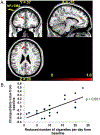Reduced executive and reward connectivity is associated with smoking cessation response to repetitive transcranial magnetic stimulation: A double-blind, randomized, sham-controlled trial
- PMID: 37996557
- PMCID: PMC11005027
- DOI: 10.1007/s11682-023-00820-3
Reduced executive and reward connectivity is associated with smoking cessation response to repetitive transcranial magnetic stimulation: A double-blind, randomized, sham-controlled trial
Abstract
Repetitive transcranial magnetic stimulation (rTMS) can reduce cue-elicited craving, decrease cigarette consumption, and increase the abstinence rate in tobacco use disorders (TUDs). We used functional magnetic resonance imaging (fMRI) to investigate the effect of 10 sessions of rTMS on cortical activity and neural networks in treatment-seeking smokers. Smoking cue exposure fMRI scans were acquired before and after the 10 sessions of active or sham rTMS (10 Hz, 3000 pulses per session) to the left dorsal lateral prefrontal cortex (DLPFC) in 42 treatment-seeking smokers (≥ 10 cigarettes per day). Brain activity and functional connectivity were compared before and after 10 sessions of rTMS. Ten sessions of rTMS significantly reduced the number of cigarettes consumed per day (62.93%) compared to sham treatment (39.43%) at the end of treatment (p = 0.027). fMRI results showed that the rTMS treatment increased brain activity in the dorsal anterior cingulate cortex (dACC) and DLPFC, but decreased brain activity in the bilateral medial orbitofrontal cortex (mOFC). The lower strength of dACC and mOFC connectivity was associated with quitting smoking (Wald score = 5.00, p = 0.025). The reduction of cigarette consumption significantly correlated with the increased brain activation in the dACC (r = 0.76, p = 0.0001). By increasing the brain activity in the dACC and prefrontal cortex and decreasing brain activity in the mOFC, 10 sessions of rTMS significantly reduced cigarette consumption and increased quit rate. Reduced drive-reward and executive control functional connectivity was associated with the smoking cessation effect from rTMS. TRIAL REGISTRATION: ClinicalTrials.gov identifier: NCT02401672.
Keywords: ACC; DLPFC; Executive control circuitry; Reward circuitry; Smoking cessation; TMS; Tobacco use disorder.
© 2023. The Author(s), under exclusive licence to Springer Science+Business Media, LLC, part of Springer Nature.
Conflict of interest statement
Figures




Similar articles
-
Two weeks of image-guided left dorsolateral prefrontal cortex repetitive transcranial magnetic stimulation improves smoking cessation: A double-blind, sham-controlled, randomized clinical trial.Brain Stimul. 2020 Sep-Oct;13(5):1271-1279. doi: 10.1016/j.brs.2020.06.007. Epub 2020 Jun 10. Brain Stimul. 2020. PMID: 32534252 Free PMC article. Clinical Trial.
-
Transcranial magnetic stimulation of the dorsal lateral prefrontal cortex inhibits medial orbitofrontal activity in smokers.Am J Addict. 2017 Dec;26(8):788-794. doi: 10.1111/ajad.12621. Epub 2017 Sep 12. Am J Addict. 2017. PMID: 28898485 Free PMC article.
-
Repetitive transcranial magnetic stimulation (rTMS) of the dorsolateral prefrontal cortex reduces resting-state insula activity and modulates functional connectivity of the orbitofrontal cortex in cigarette smokers.Drug Alcohol Depend. 2017 May 1;174:98-105. doi: 10.1016/j.drugalcdep.2017.02.002. Epub 2017 Feb 28. Drug Alcohol Depend. 2017. PMID: 28319755 Free PMC article. Clinical Trial.
-
Neuroimaging and neuromodulation approaches to study eating behavior and prevent and treat eating disorders and obesity.Neuroimage Clin. 2015 Mar 24;8:1-31. doi: 10.1016/j.nicl.2015.03.016. eCollection 2015. Neuroimage Clin. 2015. PMID: 26110109 Free PMC article. Review.
-
Brain stimulation methods to treat tobacco addiction.Brain Stimul. 2013 May;6(3):221-30. doi: 10.1016/j.brs.2012.06.008. Epub 2012 Jul 9. Brain Stimul. 2013. PMID: 22809824 Review.
Cited by
-
Modulation of High-Frequency rTMS on Reward Circuitry in Individuals with Nicotine Dependence: A Preliminary fMRI Study.Neural Plast. 2024 Aug 28;2024:5673579. doi: 10.1155/2024/5673579. eCollection 2024. Neural Plast. 2024. PMID: 39234068 Free PMC article.
References
-
- American Psychiatric Association 2013. Substance Abuse Disorder. Diagnostic and Statistical Manual of Mental Disorders. 5th ed. 10.1176/appi.books.9780890425596 - DOI
-
- Amiaz R, Levy D, Vainiger D, Grunhaus L, & Zangen A (2009). Repeated high-frequency transcranial magnetic stimulation over the dorsolateral prefrontal cortex reduces cigarette craving and consumption. Addiction, 104(4), 653–660. - PubMed
-
- Baleydier C, & Mauguiere F (1980). The duality of the cingulate gyrus in monkey. Neuroanatomical Study and Functional Hypothesis. Brain, 103(3), 525–554. - PubMed
Publication types
MeSH terms
Associated data
Grants and funding
LinkOut - more resources
Full Text Sources
Medical

